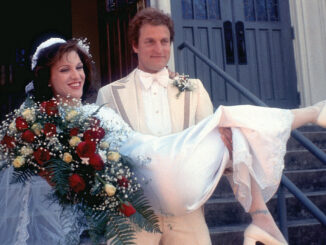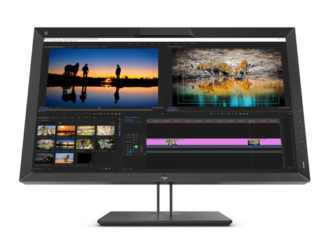
Where are you currently employed?
Sony Pictures Entertainment.
Current project(s)?
“Morbius,” “Ghostbusters: Afterlife,” “Monster Hunter,” “Fatherhood,” “Connected,” “Escape Room 2,” “Peter Rabbit 2: The Runaway,” “Venom: Let There Be Carnage”… and a few more.
Describe your job.
I’m classified as a trailer editor, but I’m not actually cutting anything creatively. I’m more of a linchpin/ problem-solver/air traffic controller. I communicate between the marketing division and the different feature post-production editorial and VFX teams that are working with the studio.
Starting with dailies, I oversee clips and preview feature films out of the cutting room for our marketing teams and the creative agencies cutting the trailers, TV/digital spots, clips, and creating print materials, and continue all the way through post-opening TV spots. Pretty much every image you see marketing a Sony movie, whether on the big screen, TV, internet, cell phone, billboards, or print ads, has passed through our department at some point.
I’m on the phone a lot (2500-3000 minutes and 700-1000 texts per month) with the other trailer editors and assistants on our team, our creative execs, the vendors, and the feature cutting rooms to go over current status of projects, request material, schedule and supervise mixes and DIs [digital intermediates, a multi-task process that involves various activities that occur after picture editing and before printing] –everything to keep things moving forward.
On a typical day, we can be working on three to ten different projects. At 7 a.m., I sit at home with coffee and my laptop, answering emails I received overnight. Maybe I’m also looking at a few QTs [QuickTime .mov files] of trailers or ad spots that are almost finished. Make calls to the different guys on our team about what’s going on currently and plans/expectations for the day. I have a DI session at CO.3 [Company 3, a post-production facility] at 10 a.m. with a director, the VFX producer, and our studio’s creative exec. The picture we’re looking at was built and sent overnight from Instinctual [another post- facility] via Aspera [IBM software that moves gigantic files – for us, it’s media files – quickly and securely over the internet]. We are still waiting on seven more VFX shots to be delivered that the director approved this morning. He says he just saw them in a review and asks why they aren’t cut yet.
At the same time, I’m texting with my coworker Dave Stockslager, who is supervising that picture build and a few others at Instinctual. “What about the blood removal?” I text. He assures me it’s getting done. At SSI Hollywood [a post- facility known for producing and mixing trailers and commercials] where we’re starting a mix, Matt G the mixer says the dialogue in the mix prep [all the audio used in the mix — dialogue, effects and music — as discrete elements that can be adjusted individually by the mixer] has some issues. We try to chase down the assistant in feature sound editorial for production tracks to see if there’s better coverage or a cleaner take. I call the creative agency who worked with our creative exec on the trailer to let them know we’ll be ready for their producer and editor to listen to a mix around 2 p.m., followed by my creative exec and the filmmakers at 4 p.m. The creative vendor then says they’re on fiber [fiber optic cable that can transmit broadband quickly and over long distances] waiting for the creative (the one I’m in the DI with) to get back with them, and they’re changing a music cue, and they’ve gone up three versions since the prep they sent last night.
Now we’re waiting on the seven VFX and a new lock on the trailer so the mix can begin. To make the delivery target, tonight we should be shipping DCPs to Deluxe labs [DCP = Digital Cinema Package: a collection of digital files used to store and convey digital cinema audio, image, and data streams] and posting QT video files of the finished trailer to our servers for the online launch and various publicity needs. My boss, Art Shapiro, tells me there are :90 and :60 cutdowns [shorter versions] of the locked trailer for international. I tell him about the cue changing… but ugh – is it just the cue that’s changing? And how does that cue change affect the :90 and the :60 versions of the trailer? We won’t know those answers until they lock the trailer again.
It’s only 11:00am. The day is just getting started….
How did you first become interested in this line of work?
Growing up in the San Fernando Valley, I always wanted to work in the studios. It seemed like everyone’s parents and other people we knew worked in the business — kind of like if you’d grown up in Detroit, you would expect to work for GM or Ford or something else related to the auto industry. My friends were starting to get jobs in the studios as drivers, laborers, construction, grips, electricians, or in editorial, camera, film labs, etc. I knew I had to get in one way or another.
Who gave you your first break?
I owe it all to Jimmy Honore, who was then the head of post-production at Columbia Pictures/Sony. From time to time, he would stop in at this place where I was bartending in Studio City. We would talk, and we became friends. Years later, I quit the bar and decided I was either going to find a studio gig or else I was moving to Hawaii to tend bar and work at a dive shop. Jimmy invited me to the studio and had one of his post supervisors, John Naveira, show me around.
John took me to a few cutting rooms. “Booty Call” (1997) had just finished its theatrical run, and they were cutting a TV version on Avid. Monica Anderson, the first assistant editor, let me and the two apprentices on the show cut clips and learn the Avid. Then, on “The Mask of Zorro” (1998), one of the assistant editors, Odis McKinney, showed me how to code film, sync dailies on the bench, and then play them on the KEM flatbed editor. I was immediately hooked, so John gave the green light for me to come in, hang out, and learn what I could.
What was your first union job?
After I’d been hanging around the studio for a while, Jimmy found out I was coming in on my own and learning. He knew I was into it and that I wasn’t going away. Coincidentally, George Hivley needed an apprentice in his department at Columbia Pictures that re-edited movies for TV broadcast and airline use. Right time, right place, right people. On April 7, 1997, I started working with editor Christopher Holmes on a TV broadcast version of “Donnie Brasco” (1997).
In July 1997, I started working for Art Shapiro in marketing post production at Sony as an apprentice, and I’ve been there ever since.
What credits or projects are you proudest of, and why?
You don’t see our names on the credits, but hopefully we did our part to get people’s attention and put butts in the seats on opening weekend. After so many years and so many titles, it’s hard to say, but I guess all the “Spider-Man” movies we’ve made, especially the first three. We worked very closely with the cutting room, the filmmakers, the heads of marketing and the studio, and everyone else involved. These were giant campaigns, a huge collaboration among so many different parties, and it all worked out so well. It was great to be part of the success we had with those films.
What was your biggest challenge in your job (or on a particular project) and how did you overcome/solve it?
Getting used to the long crazy hours and finding that balance between family and work. My wife Betty has been my solid supporter and always had my back from day one, and she’s a great influence for our daughters, Bailey and Ashley, as they have grown into great young ladies.
What was the most fun you’ve had at work?
Hurricane Marie, August 27, 2014. Crazy big swell hit the coast. My schedule opened up and to Malibu I went — I got paid to surf! Seriously, though, I can’t really point to one thing. I work with such great people. Every day is different, and we always make the best of what we have.
Jobwise, what do you hope to be doing five years from now?
I would be so happy doing the same exact thing I’m doing today – except as I look back at how my job has changed from 35mm film and ¾ inch tape to 4K DI’s and ProRes QTs and watching off-lines [edited versions in progress] on my phone, I still hope to be doing the same thing, but with the next new file formats. To quote Art Shapiro, “Make it look great, sound great, and get it where it needs to go.”
What are your outside activities, hobbies, passions?
I surf as much as possible. Been doing it over 40 years. I suck, but I love it. We do a lot of camping at the beach with my family and friends. I also play golf and fish — and yeah, I’m not good at them, either. I hope to get a boat in the next few years and get some time out on the ocean.
Favorite movie(s)? Why?
Anything with Will Ferrell, but especially “Elf” (2003). It’s a year-round favorite at my house.
Favorite TV program(s)? Why?
SportsCenter on ESPN and the NFL channel. I love sports, especially football.
Do you have an industry mentor?
Jimmy Honore and my boss Arthur Shapiro. Both of these guys are the best at what they do.
What advice would you offer to someone interested in pursuing your line of work?
You have to start somewhere and be open to anything that might get you in. You might have to take a step sideways and/or down to move up. Take your time to learn the process. Try and know how things work and stay current on technology. Things move fast and are always changing. Be patient and roll with it. Don’t be afraid to share your opinion or make a suggestion.
Was there ever a circumstance when you had to rely on the Guild for help or assistance?
No, but it’s great to know that we can come to the Guild for advice, assistance, and direction to resources if needed.
Is there anything you’d like to say to your fellow Guild members, some words of encouragement?
We need to stick together and stay informed, especially now where it seems like parts of the business are nipping away at our rights, with so many ways that companies provide content and so many ways that people view it. We need to continue organizing and encourage new membership. We need to stay relevant and protect the great benefits and compensation that we have and worked so hard for. We are so fortunate to work in such an exciting business, touching so many people globally, and to be part of the Guild and IATSE and everything it stands for. It’s a great feeling.
Compiled by David Bruskin.
Want to be profiled in this feature? Reach out to SCollins@editorsguild.com.





